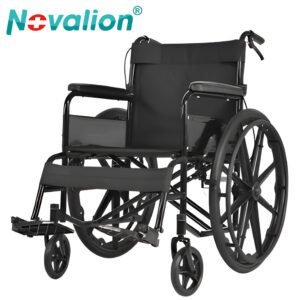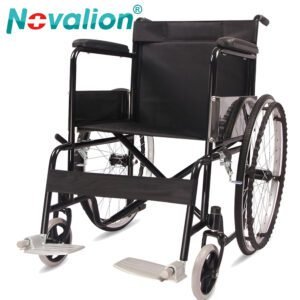Pushable Wheelchair: A Guide to Caregiver-Operated Mobility Solutions
For individuals unable to self-propel a wheelchair, a pushable wheelchair—designed to be maneuvered by a caregiver—offers a vital lifeline to independence. These models prioritize ease of use for the person pushing, while ensuring comfort and safety for the user. This guide answers all key questions about pushable wheelchairs, from their design to how to choose, use, and maintain one.
What is a pushable wheelchair?
A pushable wheelchair is a mobility device designed to be propelled by a caregiver rather than the user. Unlike self-propelled wheelchairs, which feature large rear wheels with hand rims for user-driven movement, pushable models have smaller rear wheels and are controlled via handles at the back. They are typically lightweight, compact, and built for maneuverability in tight spaces like homes, hospitals, or stores. The focus is on reducing strain for the caregiver—with features like ergonomic handles and responsive steering—while providing a stable, comfortable seat for the user. They may include basic adjustments (e.g., removable footrests) but prioritize simplicity to keep the design lightweight.
How does it differ from a self-propelled wheelchair?
The key differences lie in who controls the movement and the design priorities:
- Propulsion source: Self-propelled wheelchairs rely on the user’s upper-body strength to push hand rims, making them ideal for those with sufficient arm mobility. Pushable wheelchairs shift this effort to a caregiver, using rear handles to steer and move—essential for users with limited strength or dexterity (e.g., the elderly, post-surgery patients).
- Wheel size and design: Self-propelled models have large rear wheels (24–26 inches) to maximize user control. Pushable wheelchairs have smaller rear wheels (12–16 inches) and larger front casters, prioritizing the caregiver’s ability to navigate tight turns and narrow spaces.
- Weight and portability: Pushable wheelchairs are often lighter (25–35 lbs) than self-propelled ones (30–45 lbs), making them easier for caregivers to lift into vehicles or maneuver over curbs. Many fold compactly for storage.
Who needs a pushable wheelchair?
- Users with limited upper-body strength: Individuals with conditions like arthritis, stroke-related paralysis, or muscular dystrophy, who cannot self-propel a standard wheelchair.
- Elderly individuals: Seniors with reduced mobility or balance issues, who require assistance with daily movement but do not need the bulk of a medical-grade wheelchair.
- Post-surgery or recovery patients: Those temporarily unable to use their arms (e.g., after shoulder surgery), needing short-term caregiver support.
- Caregivers seeking ease of use: Families or professionals looking for a lightweight, maneuverable option to assist loved ones or clients in daily activities (e.g., errands, doctor visits)
What features should you prioritize when choosing one?
- Weight and maneuverability: Look for a model under 35 lbs to reduce strain on caregivers. Test how easily it turns—tight turning radii are critical for navigating home hallways or store aisles.
- Ergonomic handles: Padded, height-adjustable handles reduce caregiver fatigue during long pushes. Handles should be positioned to allow a natural grip, preventing wrist or back strain.
- Foldability: A foldable design is essential for transport and storage. Check that the folded dimensions fit in your car trunk or closet—most fold to 12–18 inches thick.
- Safety features: Reliable brakes (preferably foot-operated, allowing caregivers to stop without releasing the handles) and a stable base to prevent tipping. Removable footrests simplify transfers.
- User comfort: A padded seat and backrest, with sufficient width (16–20 inches) to avoid pressure points. Adjustable leg rests help maintain proper posture.
How to use a pushable wheelchair safely?
- Pre-use checks: Ensure brakes engage securely and footrests are locked in place before transferring the user. Check that the frame is stable—no loose bolts or wobbly wheels.
- Transfer protocol: Lock the brakes, fold or remove footrests, and assist the user into the chair. Avoid sudden movements during transfers, as pushable models are lighter and may shift more easily than self-propelled ones.
- Caregiver posture: Push from the legs, not the back, to avoid strain. Keep a straight posture, with hands gripping handles at waist height—hunching increases injury risk.
- Terrain awareness: Slow down on uneven surfaces (e.g., sidewalk cracks) and use ramps instead of curbs when possible. Tilt the chair slightly backward (with caregiver lifting the front) to navigate small obstacles.
What maintenance is required?
- Frame and handle care: Wipe down the frame and handles weekly with a damp cloth to remove dirt and sweat. For metal frames, check for rust—treat with rust-resistant spray if needed.
- Wheel and brake upkeep: Inspect tires for wear (replace if cracked) and keep them inflated (for pneumatic models). Test brakes weekly—adjust or replace pads if they feel loose. Lubricate wheel axles monthly to ensure smooth movement.
- Folding mechanism checks: If the wheelchair folds, clean hinges monthly to remove debris that could jam the mechanism. Tighten loose screws to maintain stability when folded or unfolded.
Where can you buy a pushable wheelchair?
- Medical supply stores: In-person shops allow testing of maneuverability and fit, with staff to explain features. Chains like Walgreens or local medical supply retailers often stock popular models.
- Online retailers: Amazon, Walmart, and mobility-specific sites (like novalion-med.com) offer a wide range, with customer reviews highlighting ease of use for caregivers. Look for free returns to test at home.
- Rental options: For short-term needs (e.g., post-surgery recovery), rental companies provide pushable wheelchairs at daily or weekly rates, avoiding the cost of buying.
A pushable wheelchair bridges the gap between dependence and mobility, empowering users to stay active with caregiver support. By prioritizing lightweight design, ergonomic features, and safety, these wheelchairs make daily outings and tasks manageable for both users and their caregivers.
Thank you for reading this, dear. If you have any suggestions about our website or want to know about wheelchair, please contact us. We will respond quickly.



